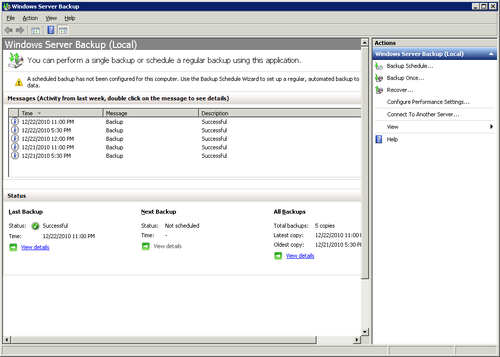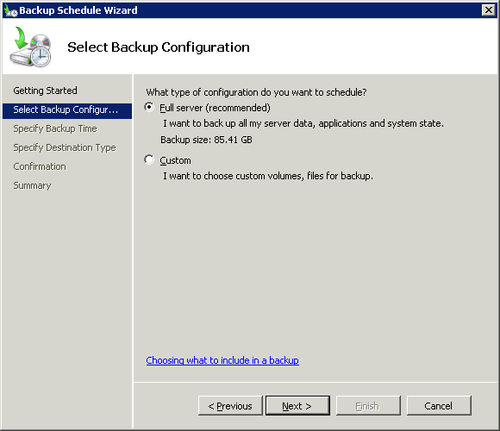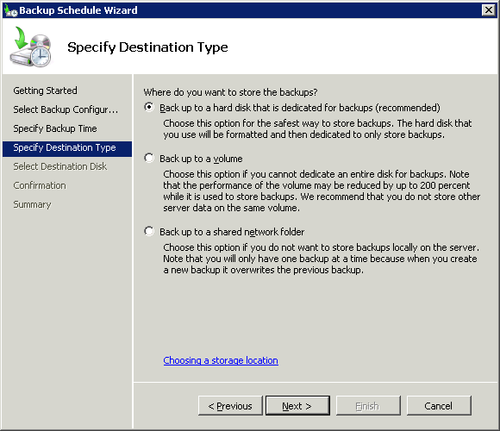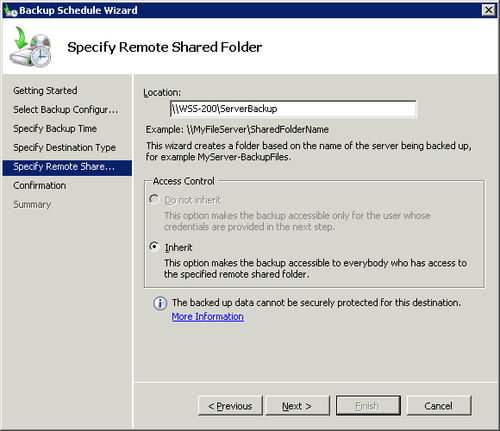2. Windows Server Backup Using Native Tools
The alternative to using the Configure Server Backup Wizard in the Windows SBS
Console is to run the native Windows Server Backup console, shown in Figure 7. By configuring your SBS server’s backup using the
Windows Server Backup console, you have additional
configuration choices while still fully protecting
your SBS server.

2.1. Create a Backup Schedule
The native tools equivalent of the Configure Server Backup
Wizard is the Backup Schedule Wizard, which is launched by
selecting the Backup Schedule task on the Actions menu. This
wizard configures the backup type, file selection, backup
destination, and the backup frequency.
To create a new backup schedule that backs up the entire
server, open the Windows Server Backup application and then use the
following steps:
Select Backup Schedule from the Actions menu to open the
Backup Schedule Wizard, shown in Figure 8.

Click Next to open the Select Backup Configuration page
of the Backup Schedule Wizard as shown in Figure 9. Select
Full Server (Recommended).

Click Next to open the Specify Backup Time page. The
default is once a day, but you can choose to have backups happen more frequently.
Click Next to open the Specify Destination Type page,
shown in Figure 10. The
choices are
Back Up To A Hard Disk That Is
Dedicated For Backups (Recommended) This option
behaves essentially the same as running the SBS Configure
Server Backup. You must have a separate, dedicated hard
disk, preferably external, that will be used only for
Windows Server Backup. The disk is formatted
before initial use and does not get assigned a drive
letter.
Back Up To A Volume
This option allows the backup files to share an existing
volume on the SBS server. This significantly impacts the
performance of the volume and should be selected only if
there is no other viable option.
Back Up To A Shared Network
Folder This option allows you to back up to
another computer on the network that has shared disk
space, such as a Windows Storage Server 2008 R2 Essentials (WSSE)
server. However, this option only keeps a single backup
file, so you won’t have multiple generations of backups.
If you choose this, you should do a secondary backup of
the backup file to another location to provide a way to
recover older generations of backups.

Specify the destination type and then click Next to open
the Select Destination Disk, Select Destination Volume, or
Specify Remote Shared Folder page. The options on this page
will vary slightly depending on which type you choose. For
this step, we’ll choose a shared folder on the WSSE server, as shown in Figure 11.

Click Next and you’ll be prompted for credentials to
connect to the remote shared folder. Provide the credentials,
click OK, and then click Finish to complete the Backup Schedule Wizard.
Note:
If the computer hosting the shared volume is in a
workgroup and is not a member of the SBS domain, you’ll need
to provide credentials for the remote computer that won’t
cause issues. The trick is to have a local user on the
remote computer that has the same user name (and password)
as an administrator for the SBS network. When asked to
specify the credentials for the share, use the user name
alone, not the DOMAIN\Username format.
So, for example, I used Charlie as the
user name, not EXAMPLE\Charlie or
WSS-200\Charlie.
Click Close to close the wizard and return to the
Windows Server Backup console.
2.2. Changing the Backup Configuration
Even when you use the native Windows Server Backup console to configure backups,
you can still use the Windows SBS Console to modify some of the
settings. Click Backup And Server Storage and then click on the
Backup tab. When you select the currently configured backup, the
Tasks pane updates to show the changes you can make as well as
providing details about the current backup configuration. You
can
Add or remove backup items (entire volumes only)
Change the backup schedule
Temporarily pause backups (without changing other
settings)
Disable the backups (deletes the current configuration
entirely)
What you can’t do from the Windows SBS Console is change the
backup destination, or change what items on a particular volume
are backed up. To make these changes, you need to open the Windows
Server Backup console and select Configure Backup Schedule.